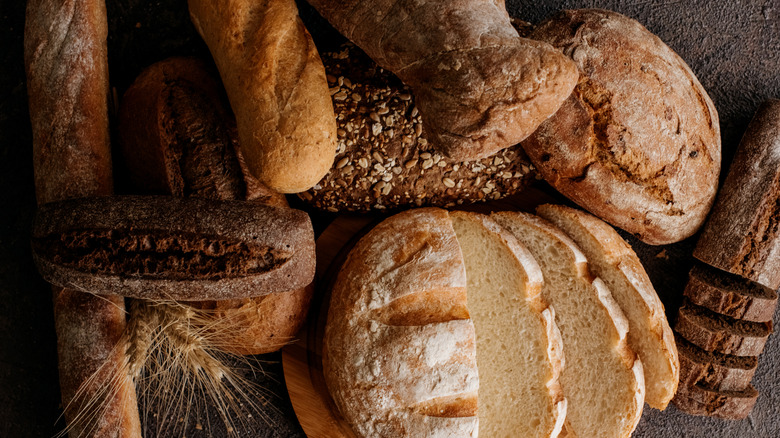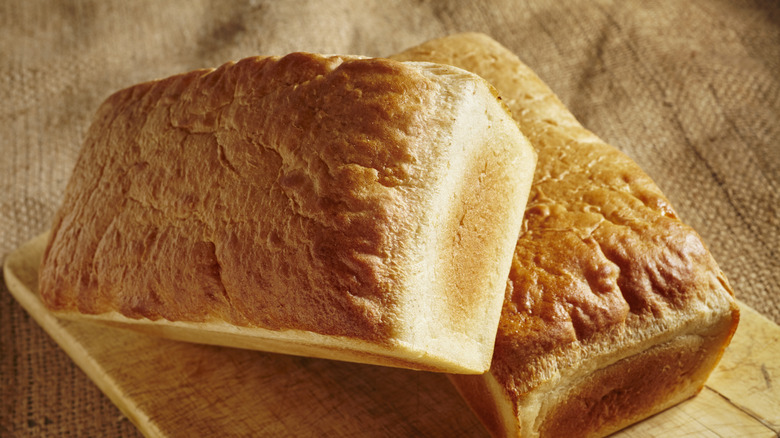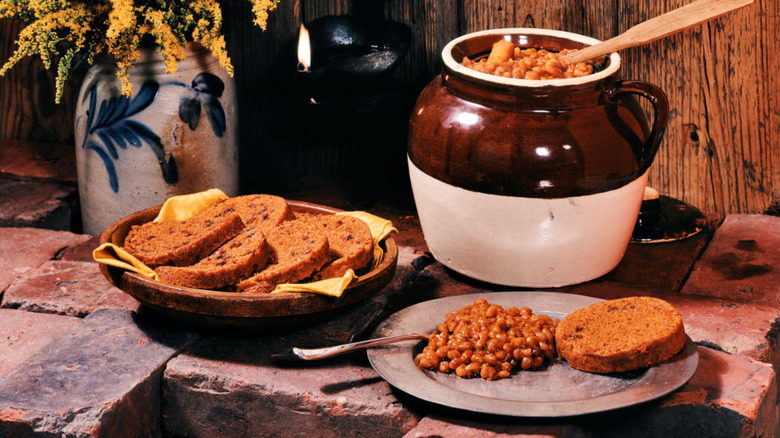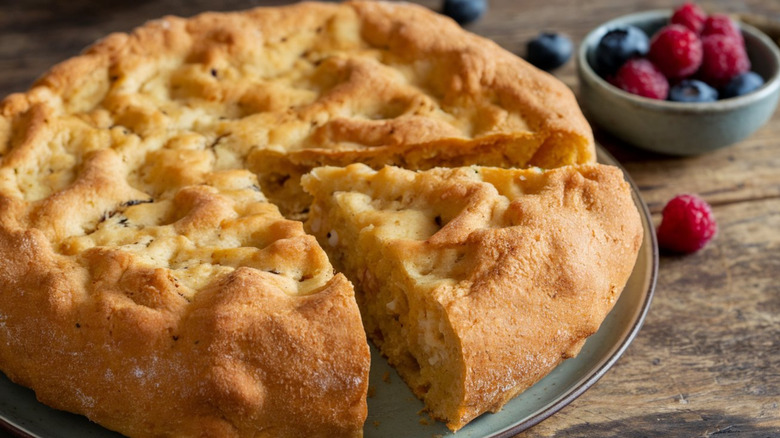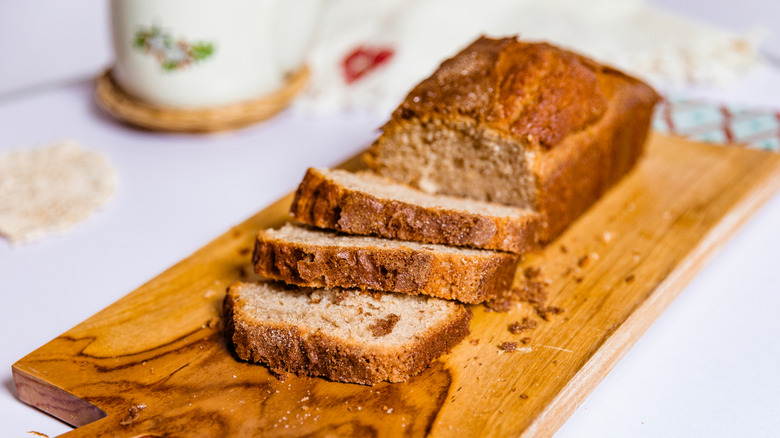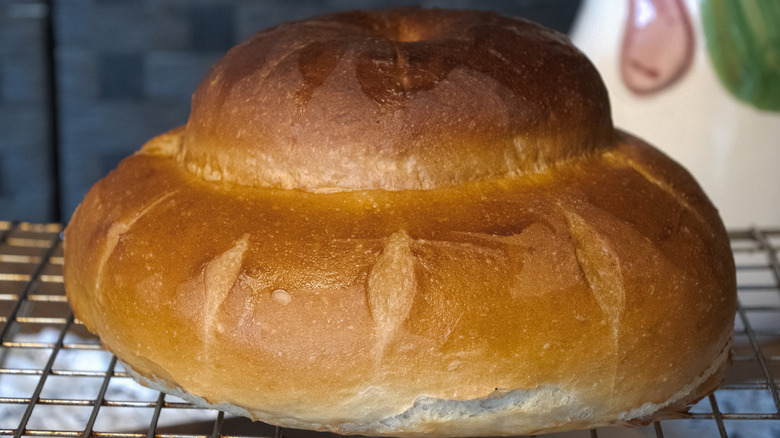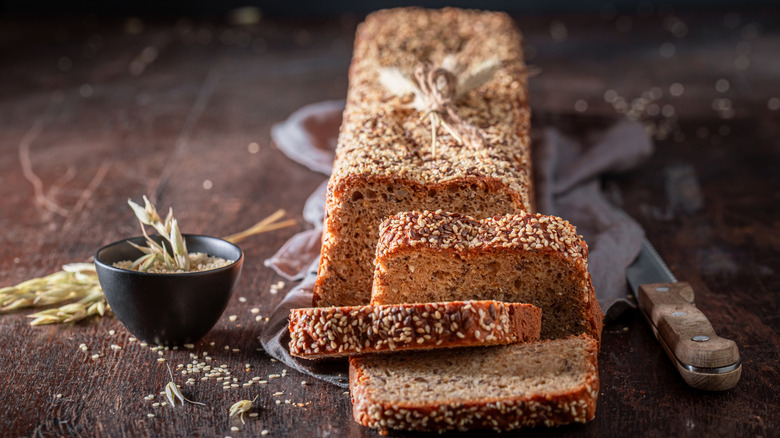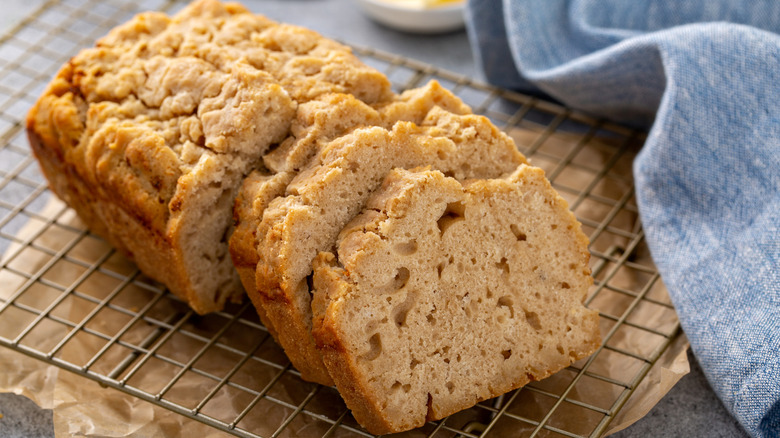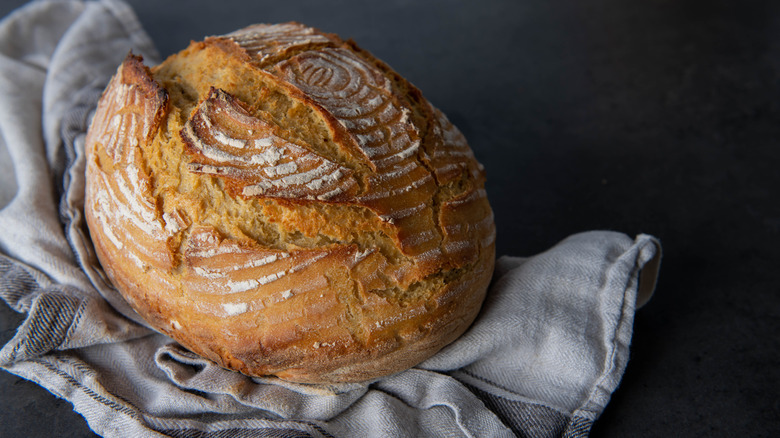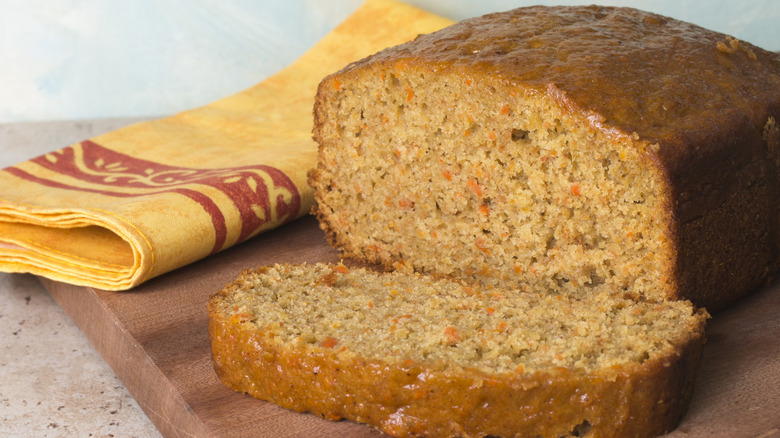11 Old-School Breads You Won't Find At Your Local Bakery
We may receive a commission on purchases made from links.
Whether you're savoring a bagel at breakfast, toasting a sandwich for lunch, or enjoying slices of baguette at dinnertime, bread is an essential part of many meals, rooted in tradition and community. Archaeological evidence indicates that humans have been producing bread since prehistoric times, and this staple has evolved over thousands of years as it's been adopted by cultures around the world.
At its most basic, bread is made with flour and water, while yeast and salt are often mixed in. But these simple ingredients provide the foundation for a lot of variation, including different types of flour used, varying rising times allotted, and the use of leavening agents like baking powder.
While humankind has been eating bread for millennia, in the United States, bread production is intertwined with the country's entire history. In the 1800s, the shift toward industrialization saw bread-making move from kitchens and small-scale bakeries to huge factories churning out identical loaves. However, many rustic breads of yesteryear are now making a comeback — from the resurgence of homemade sourdough during the pandemic to recently renewed interest in artisanal loaves. Still, the offerings at your local bakery are likely to be a predictable selection of well-known varieties like whole wheat, sourdough, and brioche. Delicious as those can be, let's take a look back at forgotten styles of old-school breads that deserve our attention, too.
Salt-rising bread
If you're out of yeast but have cornmeal in the pantry, you can still make this type of bread in a pinch. Instead of harnessing the power of yeast, salt-rising bread uses a potentially dangerous bacteria found in cornmeal (Clostridium perfringens) to rise, giving each loaf a distinctly funky quality. Without yeast, the process of making this bread requires careful attention to temperature and timing, but this technique was prized by rural homemakers of bygone times who had scant access to leavening agents. Amidst the rise of commercially produced breads, salt-rising bread became associated with nostalgic home baking, based on recipes passed down through generations.
Salt-rising bread was commonly prepared by settlers in the Appalachian region during the 1700s, where pioneer women faced the conditions of their remote locations with resourcefulness. This bread is still made in the Appalachian states, as some bakers are reigniting the tradition. You can also make salt-rising bread at home with some time and patience. The results are worth it — this thick white bread is beloved for its softness. However, its unique cheese-like flavor (a result of the fermentation of bacteria instead of yeast) is more divisive. Some can't get past the starter's stinky quality, which has been likened to the smell of feet. Regardless, fans of the bread laud its sweetness.
Canned bread
The history of canned bread actually predates the invention of canning. When early European settlers arrived to New England, they responded to the region's poor wheat-growing conditions by creating a type of bread consisting of wheat, rye, and cornmeal. Molasses was later added to the recipe, and the resulting style of thick, dark bread became a culinary icon of New England.
During the 1920s, canned-food producer B&M began canning this type of brown bread, and this unlikely product took off. Its shelf life made canned bread a natural addition to army rations. New Englanders grew up eating B&M's canned bread alongside baked beans and hot dogs, but others find that the circular loaf's soft texture and sweet flavor — often enhanced with raisins — make it more of a dessert-style bread.
Like all canned products, this bread is known for its convenience, as it's ready to eat at room temperature straight out of the can. For a little more excitement, some prefer to warm it up before layering slices with butter. Despite the vintage feel of canned bread, B&M still produces it to this day — you can buy it directly at New England grocery stores or from Amazon.
Bannock
Bannock is a classic type of bread in Canada, where it has two widely believed origin stories. According to one version, bannock was brought to Canada by Scottish settlers in the late 1700s, who made it with barley or oatmeal, and later introduced this bread to the Indigenous people. The other story asserts that Indigenous groups already had their own version of bannock, made with bulbs from a plant called camas.
Regardless of bannock's true origins, as Indigenous Canadians were forced to abandon their traditional foods, the recipe adapted to include European ingredients like flour, lard, and sugar, making this a heartier (if not healthier) staple. Today, this nationally cherished food maintains a complex identity: It's seen as a symbol of colonization, but Indigenous recipes for bannock bread are also revered.
Nowadays, a typical bannock recipe is made with flour, lard, baking powder, salt, and water. (It can contain milk and eggs as well, but these ingredients are not considered as being traditional.) This quick bread is versatile to prepare, as it can be deep-fried, baked, or cooked over an open fire. Depending on how bannock is prepared, it can be thick and slightly chewy or light and airy, and it can be served with a savory meal — even serving as a burger bun — or as a sweet treat topped with jam. Since it contains no yeast and is made with pantry staples, you can easily make this bread on a stovetop skillet at home, or over a campfire.
Amish friendship bread
In the same spirit as the expression "breaking bread," Amish friendship bread acts as a bridge of connection. There's nothing particularly unique about the ingredients — it's primarily made with flour, milk, sugar, eggs, and oil. What makes it special is how this bread's starter is prepared and shared. After letting the starter ferment for 10 days and saving some for yourself to bake, the remaining starter is customarily split up and given to friends.
Where did this heartfelt tradition come from? The exact origins remain unclear, but as the name implies, the tradition is believed to have started in the Amish community, where home bakers would bake this bread and share the starter as an expression of care and support. While friendship bread took off in the United States in the 1980s, there is evidence that friendship cake — which was similarly made with a starter shared among friends — was baked as far back as the 1860s.
The simple recipe for Amish friendship bread has evolved over time, with bakers making it their own by using a variety of flours and other ingredients. Sweeter iterations of Amish friendship bread may contain cinnamon, and can have a texture similar to pound cake. By the end of the 20th century, the friendship bread recipe typically called for a packet of instant pudding, which is considered a divisive addition.
Cottage loaf
George Orwell praised the taste of cottage loaves while lamenting their dwindling availability in one of his essays from the 1940s. As was so often the case, this great British author's observation proved prescient, as the cottage loaf became something of a lost art form by the end of the 20th century. Its distinct shape — appearing like two round loaves stacked on top of each other — is considered to be a relic of Britain's era under Roman occupation, when communal ovens necessitated stacking bread loaves to save space.
The shape of the cottage loaf makes it particularly challenging to bake, since the top part can collapse into the bottom loaf. But it's worth the time and effort to taste the bread's fluffy interior and crispy crust. While this type of bread has largely disappeared from bakery shelves, it's a beloved loaf among those in the know. Virginia Woolf reportedly mastered the difficult recipe, according to her cook Louie Mayer, who recounted that the writer taught him how to make the perfect cottage loaf. More recently, preparing a cottage loaf has been presented as a challenge on "The Great British Bake Off," inspiring home bakers to take on the vintage recipe themselves.
Graham bread
Sylvester Graham was a health-food visionary, although the bizarre reason why he invented graham crackers had more to do with spiritual purity than physical well-being. While graham crackers are still available at most grocery stores, the bread that he created out of the same graham flour is often overlooked.
Seen as a pioneer of the vegetarian movement, Graham was an American preacher who developed a devout following in the 1830s for his ideas about health. One of the principles he espoused was that whole wheat is superior to white flour, as the latter contained additives and lacked fiber and nutrients. Homemade graham bread was promoted as a nourishing alternative to white bread, as it was made with Graham's own coarse version of whole-wheat flour, which didn't have the bran and germ stripped from the wheat kernel.
Graham flour was combined with milk, molasses, salt, and yeast to make this bread, resulting in a dark, dense loaf that was especially high in fiber. The bread was popular among those who religiously followed the "Graham Diet" that emphasized eating fresh fruits and vegetables instead of meat. Graham's popularity was short-lived, declining in the 1840s until he died in 1851. However, his name lives on with the graham cracker — a commercialized pantry staple that is a far cry from Graham's original recipe. While graham bread is no longer in fashion, you can still bake it at home if you can get your hands on graham flour.
Beer bread
Like bread, beer is a fermented product made from grains, water, and yeast, which has been a human dietary staple among various cultures around the world for centuries. So, it was only a matter of time before the two were combined.
Baking soda became commercially available in the mid-19th century, and led to the widespread preparation of quick bread. However, quick breads can be very dense, unlike lighter yeasted breads — but by adding beer to the dough, it was discovered that the carbonation of suds lightens the bread's consistency, and can even deliver more flavor.
That flavor is what makes beer bread a vintage loaf worth baking — unlike water, you can tailor the bread to your liking based on the kind of beer you choose. A loaf made with stout will have a more prominent flavor, as you'll find with this easy beer bread recipe. Meanwhile, a bread containing fruit beer will naturally be a sweeter loaf, delicious when spread with butter and jam. Regardless of the type of beer you use, a typical recipe also calls for flour, baking powder, salt, and sugar. Best of all, it's easy to make, and can be ready to eat in just about an hour.
Einkorn bread
When it comes to old-school breads, few go back as far in history as einkorn. There is evidence of people eating einkorn during the Paleolithic era, while remnants of einkorn bread were found in the stomach of Ötzi the Iceman, whose mummified remains — dating back to 3300 B.C. — were found in the Alps near the modern-day border of Italy and Austria.
Einkorn bread might taste similar to your typical whole wheat loaf, but it's packed with nutrients. What makes the einkorn grain so unique is that it's not hybridized, and its low gluten content is relatively easy to digest. Compared to typical wheat, einkorn contains more protein and less starch, and boasts essential minerals like iron, magnesium, and zinc. This nutritious loaf has a rich flavor that some consider nutty, making the grain ideal for baking a sweet loaf like banana bread.
Following the 20th-century industrialization of bread production, einkorn gradually became less popular in favor of grains that are easier to harvest at scale. But due to a renewed interest in heirloom grains and nutrient-rich wheat, einkorn bread is making a comeback. If you can find einkorn flour, you can make einkorn bread at home — but it may take a few tries before perfecting your loaf, as the dough can be challenging to work with.
Basque sheepherder's bread
This forgotten loaf hails from Europe's Basque region straddling France and Spain, where sheepherders used ingenuity to bake bread in a cast-iron pot placed in a hole in the ground lined with hot coals. The namesake bread came to America with Basque emigrants who migrated to the U.S. in the 19th century. Settling in Western states like California, Nevada, Wyoming, and Idaho, these sheepherders continued to bake their bread like they would back home, using Dutch ovens in a pit of hot embers.
The bread's popularity spread across the West, and its legacy lives on at Erick Schat's Bakkery in Bishop, California. This establishment first opened for business in 1938, and the bakery carries on the tradition of Basque sheepherder's bread by making each loaf by hand. The shape of the pot gives the bread its distinctive and large round form. Its size may intimidate home bakers, but the recipe is straightforward, calling for water, butter, sugar, salt, yeast, and flour. You'll be grateful for committing the effort required once you taste this airy, slightly sweet loaf.
Carrot bread
You've likely heard of zucchini bread and carrot cake — but have you ever tried carrot bread? This vintage loaf is believed to have originated in Europe during the 19th century, in response to high wheat prices. Root vegetables were reportedly tested in bread recipes as an economical alternative to wheat, and carrots were discovered to be a flavorful substitute.
Like carrot cake, carrot bread carries the natural sweetness of carrots, which can be further enhanced with the inclusion of maple syrup or honey. The carrots also make the bread particularly moist, although baking times can vary depending on the water content of the carrots used. There is also variation in carrot bread's appearance and texture depending on how the carrots are prepared, with grated carrots resulting in a more attractive loaf. Along with the carrots, you'll need flour, yeast, water, butter, and salt to make this bright-orange loaf, but the recipe can be tailored to your liking with the addition of complementary ingredients like cinnamon, raisins, or vanilla extract.
Beaten biscuits
As the name implies, these biscuits are made possible by beating the dough. Yeast is not included among the ingredients for this simple recipe, and so brute force is what gets the dough to rise. This inventive hack dates back centuries, when leavening agents were hard to come by. The act of repeatedly beating the dough would introduce tiny air pockets into the bread, allowing it to gain a lighter texture during baking. Beaten biscuits became an American breakfast staple commonly served with country ham, but as baking powder became widely available by the mid-19th century, their popularity began to wane.
The beloved beaten biscuit was saved by the invention of the biscuit brake by Evelyn L. Edwards in 1877, which imitated the act of beating with hand-cranked rollers. However, it was the self-taught baker Annie Fisher who arguably cemented the beaten biscuit into Southern food history with her fluffy biscuits that were sought out nationwide, and made her into a seminal Black woman entrepreneur.
You can take a whack at a Southern recipe for beaten biscuits, but it'll definitely be a workout. You don't need a biscuit brake — just flour, lard (or shortening), water, salt, and a lot of energy. The result is a buttery, cracker-like biscuit with a distinctly firm texture, best eaten in true Southern fashion with a slice of country ham.
